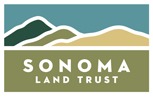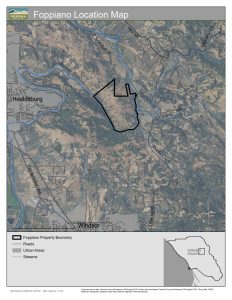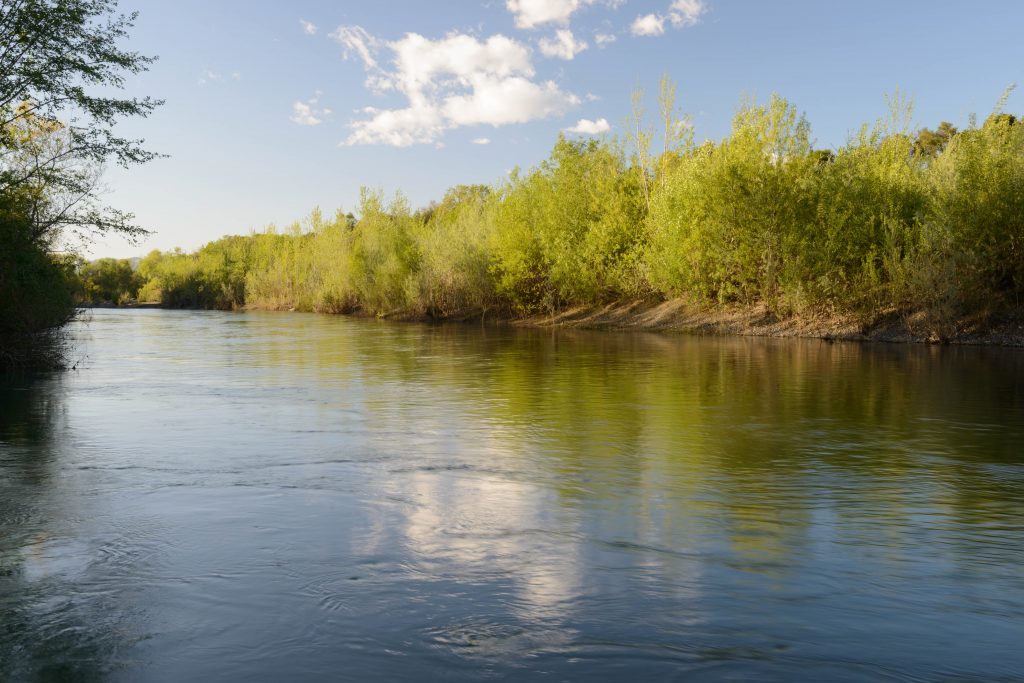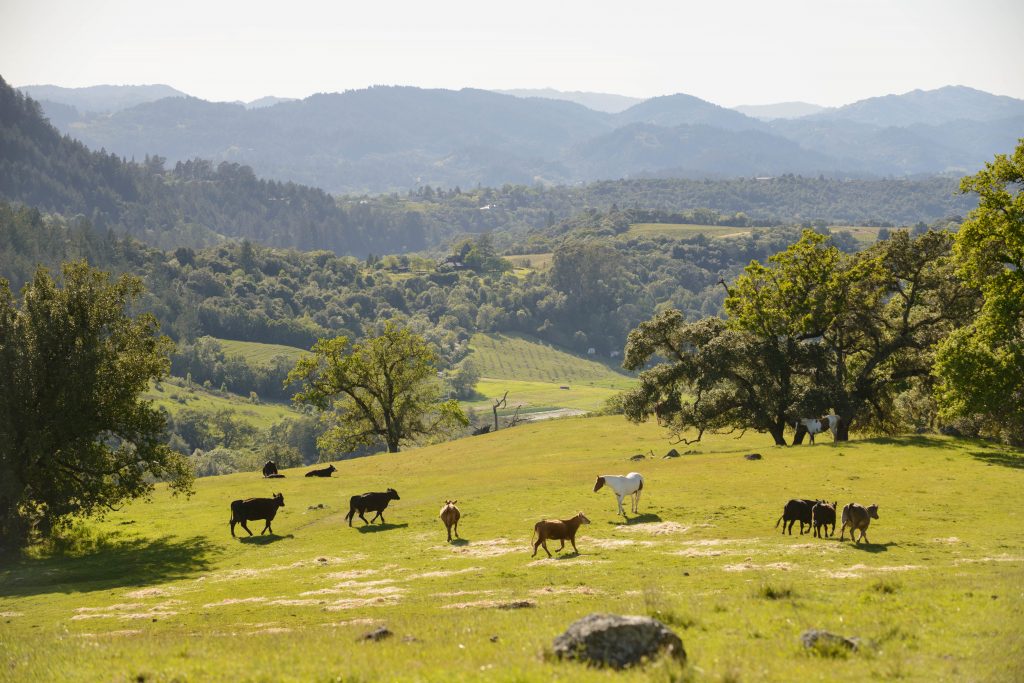Press Release
Sonoma Land Trust protects large Russian River ranch outside Healdsburg
May 11, 2021More than a pretty place, Walter and Jean Foppiano Ranch offers extensive natural benefits
Sonoma Land Trust has protected one of the largest remaining ranches along the middle reach of the Russian River — a cattle ranch on a beautiful peninsula of rolling hills and grasslands one mile east of Healdsburg and bounded on three sides by the Russian River. On April 30, the Land Trust closed escrow on a conservation easement over the 758-acre Walter and Jean Foppiano Ranch belonging to their daughters, Ruth Ann Foppiano and Christine Foppiano Haun.
“My mother and father worked hard their whole life and were both very proud of the ranch,” says Haun. “They would be pleased with this result that my sister and I chose for it.”
“This charismatic ranch is really close to Healdsburg, but feels a world away,” says land acquisition program manager, Sara Press. “With an easement over this biologically rich property, we’re protecting the ecological function of an important stretch of the Russian River.”
The development risk in this part of the county is high. Under the conservation easement, which extinguishes the possibility of up to six estate homes and/or large-scale vineyards, the ranch’s meadows, woodlands and nearly three miles of river frontage and streamside habitat will remain undeveloped forever. The easement allows for sustainable grazing agriculture — a small herd of cattle will continue to graze peacefully there.
Protecting the ranch ensures that this landscape can continue to deliver its ecosystem benefits, including:
- filtering water that is part of a system that provides drinking water to more than 600,000 residents in Sonoma and Marin counties;
- recharging groundwater at a rate of 702 acre-feet per year, which is equivalent in volume to the annual water use of 3,600 households (Bay Area Greenprint); and
- storing almost 14,000 metric tons of greenhouse gas equivalent in the above-ground vegetation and over 40,000 metric tons of greenhouse gas equivalent in the soil (Bay Area Greenprint), which together are equivalent to the annual energy use of over 6,000 homes (EPA).
Recent history of the ranch In the mid-1950s, Walter Foppiano, his brother and sister purchased the original 1,600-acre ranch across from where the Maacama Creek converges with the Russian River. Over time, their families separated their holdings, ultimately leaving Christine and Ruth Ann with their parents’ 758-acre portion. Sonoma Land Trust’s purchase of a conservation easement over the property allows the ranch to remain as it has been for the last 70-plus years and to provide a vehicle to settle the estate.
“I enjoyed going out with my dad to help take care of the sheep and, in later years, cattle,” says Haun. “I learned how to ride a horse, to appreciate what needed to be done when caring for livestock and to have patience — and I came to realize just how lucky I was growing up as a child. My husband and I enjoy immensely being at the ranch every day just like my dad did.”
Property offers extensive biodiversity
The ranch is located within a wildlife movement corridor connecting Fitch Mountain and Modini Mayacamas Preserve, and its protection will provide enduring climate adaptation and resilience benefits for native plants and animals, including intact riparian (streamside) habitat and habitat connectivity. Thanks to unusual geology and hydrology at this site, the Russian River makes a big loop around the property, surrounding it on three sides. The ample water and undeveloped nature of the ranch benefits numerous species of wildlife — even mountain lion tracks have been seen from time to time along the sandy riverbank.
Conserving this property will also help protect at-risk aquatic species that include Coho salmon, steelhead trout, California freshwater shrimp, red-legged frog and foothill yellow-legged frog. The entire ranch is considered essential for conservation by the Conservation Lands Network, a respected regional conservation strategy for the San Francisco Bay Area.
Funding for easement purchase
Funding to purchase the conservation easement was secured from the Natural Resources Conservation Service’s Agricultural Conservation Easement Program; the California Strategic Growth Council’s Sustainable Agricultural Lands Conservation program with funds from California Climate Investments, a statewide initiative that puts billions of Cap-and-Trade dollars to work; and the Bay Area Conservation Small Grants Program of Resources Legacy Fund, which is funded in part by the Gordon and Betty Moore Foundation.
“Congratulations to the Foppiano family and the Sonoma Land Trust for protecting the Foppiano Ranch forever,” says Jessica Buendia, acting executive director of the California Strategic Growth Council, which supported the land acquisition with an award through its Sustainable Agricultural Lands Conservation Program. “Protecting these 758 acres is a powerful example of how actions with major local benefits help advance important State goals to reduce and avoid greenhouse gas emissions, to protect and recharge groundwater, and to conserve natural and working lands.”
A Force for Nature Campaign
Protecting this property along the Russian River is a project of the $80 million “A Force for Nature” fundraising campaign that Sonoma Land Trust will launch publicly on May 25, 2021. The campaign funds land protection work, such as the Foppiano Ranch project, as well as other nature-based projects and programs aimed at fostering climate resilience. Thanks to generous support from individuals, businesses, foundations and government entities, we are more than 70 percent of the way to reaching the goal. Join us May 25 to learn more about the campaign. https://give.sonomalandtrust.org/forcefornature
# # #
About Sonoma Land Trust
Sonoma Land Trust works in alliance with nature to conserve and restore the integrity of the land with a focus on climate resiliency and is also committed to ensuring more equitable access to the outdoors. Since 1976, Sonoma Land Trust has protected more than 56,000 acres of scenic, natural, agricultural and open land for future generations. Sonoma Land Trust is the recipient of the 2019 Land Trust Alliance Award of Excellence and is accredited by the Land Trust Accreditation Commission. For more information, please visit www.sonomalandtrust.org.
About NRCS’ Sonoma County Venture Conservation Regional Conservation Partnership Program
NRCS’ Sonoma County Venture Conservation (SCVC) Regional Conservation Partnership Program (RCPP) is a collaboration of partners, funders, residents, farmers and ranchers working to conserve and restore land in Sonoma County to ensure resilience to climate change through healthy soils, high-quality surface and groundwater supplies, healthy habitat for fish and wildlife, and a thriving agricultural industry. The Partnership received a five-year $8,049,000 grant for activities such as protecting agricultural land through conservation easements. For more information about RCPP, visit https://www.sonomaopenspace.org/projects/sonoma-county-venture-conservation-partnership/.
About Sustainable Agricultural Lands Conservation Program
The Sustainable Agricultural Lands Conservation Program (SALC), a component of the California Strategic Growth Council’s Affordable Housing and Sustainable Communities (AHSC) Program, supports California’s greenhouse gas (GHG) emission reduction goals by making strategic investments to protect agricultural lands from conversion to more GHG-intensive uses. Protecting critical agricultural lands from conversion to urban or rural residential development encourages infill development within existing jurisdictions, ensures open space remains available, and supports a healthy agricultural economy and resulting food security. A healthy and resilient agricultural sector is a critical part of meeting the challenges occurring and anticipated as a result of climate change.
Administered by the Department of Conservation’s Division of Land Resource Protection, SALC is part of California Climate Investments, a statewide program that puts billions of Cap-and-Trade dollars to work reducing GHG emissions, strengthening the economy, and improving public health and the environment — particularly in disadvantaged communities. The Cap-and-Trade program also creates a financial incentive for industries to invest in clean technologies and develop innovative ways to reduce pollution. California Climate Investments projects include affordable housing, renewable energy, public transportation, zero-emission vehicles, environmental restoration, more sustainable agriculture, recycling, and much more. At least 35 percent of these investments are located within and benefiting residents of disadvantaged communities, low-income communities, and low-income households across California. For more information, visit the California Climate Investments website at: www.caclimateinvestments.ca.gov.



